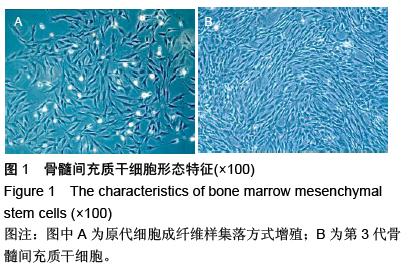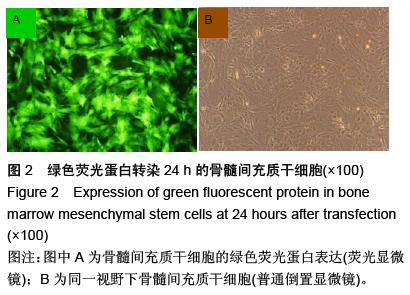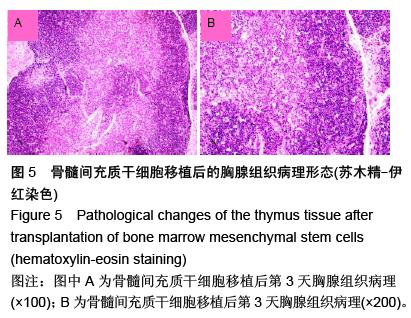| [1] 苗忠澄,高航.BMP-2预诱导骨髓间充质干细胞移植治疗大鼠再灌注后心肌梗死的实验研究[J].解放军医学杂志, 2014,39(8):601-608.[2] Pileggi A, Xu X, Tan J,et al.Mesenchymal stromal (stem) cells to improve solid organ transplant outcome: lessons from the initial clinical trials.Curr Opin Organ Transplant. 2013;18(6):672-681.[3] Vater C, Kasten P, Stiehler M.Culture media for the differentiation of mesenchymal stromal cells.Acta Biomater. 2011;7(2):463-477.[4] Hu SL, Lu PG, Zhang LJ,et al.In vivo magnetic resonance imaging tracking of SPIO-labeled human umbilical cord mesenchymal stem cells.J Cell Biochem. 2012;113(3):1005-1012.[5] 施明,刘振文,张政,等.干细胞治疗终末期肝病的进展与挑战[J].解放军医学杂志,2013,38(8):685-692.[6] Lee RH, Yoon N, Reneau JC,et al.Preactivation of human MSCs with TNF-α enhances tumor-suppressive activity.Cell Stem Cell. 2012;11(6): 825-835.[7] Bernardo ME, Fibbe WE.Mesenchymal stromal cells: sensors and switchers of inflammation.Cell Stem Cell. 2013;13(4):392-402.[8] Ma S, Xie N, Li W,et al.Immunobiology of mesenchymal stem cells.Cell Death Differ. 2014;21(2): 216-225.[9] 龚国清,徐黻本.小鼠衰老模型的研究[J].中国药科大学学报,1991,22(2):101-103.[10] Zhang X, Jiao C, Zhao S.Role of mesenchymal stem cells in immunological rejection of organ transplantation.Stem Cell Rev. 2009;5(4):402-409.[11] Wang Y, Zhang A, Ye Z,et al.Bone marrow-derived mesenchymal stem cells inhibit acute rejection of rat liver allografts in association with regulatory T-cell expansion.Transplant Proc. 2009;41(10):4352-4356.[12] Cohen JL, Sudres M.A role for mesenchymal stem cells in the control of graft-versus-host disease. Transplantation. 2009;87(9 Suppl):S53-54.[13] Baron F, Lechanteur C, Willems E,et al. Cotransplantation of mesenchymal stem cells might prevent death from graft-versus-host disease (GVHD) without abrogating graft-versus-tumor effects after HLA-mismatched allogeneic transplantation following nonmyeloablative conditioning.Biol Blood Marrow Transplant. 2010;16(6):838-847.[14] Gao L, Liu F, Tan L,et al.The immunosuppressive properties of non-cultured dermal-derived mesenchymal stromal cells and the control of graft-versus-host disease. Biomaterials. 2014;35(11):3582-3588. [15] Wan CD, Cheng R, Wang HB,et al. Immunomodulatory effects of mesenchymal stem cells derived from adipose tissues in a rat orthotopic liver transplantation model.Hepatobiliary Pancreat Dis Int. 2008;7(1):29-33. [16] Klyushnenkova E, Mosca JD, Zernetkina V,et al.T cell responses to allogeneic human mesenchymal stem cells: immunogenicity, tolerance, and suppression.J Biomed Sci. 2005;12(1):47-57.[17] Aldinucci A, Rizzetto L, Pieri L,et al.Inhibition of immune synapse by altered dendritic cell actin distribution: a new pathway of mesenchymal stem cell immune regulation.J Immunol. 2010;185(9):5102-5110. [18] Peng Y, Chen X, Liu Q,et al.Mesenchymal stromal cells infusions improve refractory chronic graft versus host disease through an increase of CD5+ regulatory B cells producing interleukin 10.Leukemia. 2015 ;29(3): 636-646.[19] Nazarov C, Lo Surdo J, Bauer SR,et al.Assessment of immunosuppressive activity of human mesenchymal stem cells using murine antigen specific CD4 and CD8 T cells in vitro.Stem Cell Res Ther. 2013;4(5):128.[20] Burr SP, Dazzi F, Garden OA.Mesenchymal stromal cells and regulatory T cells: the Yin and Yang of peripheral tolerance.Immunol Cell Biol. 2013;91(1):12-18.[21] Luz-Crawford P, Kurte M, Bravo-Alegría J,et al. Mesenchymal stem cells generate a CD4+CD25+ Foxp3+ regulatory T cell population during the differentiation process of Th1 and Th17 cells.Stem Cell Res Ther. 2013;4(3):65.[22] Zhao K, Huang F, Peng YW,et al.Clinical observation of mesenchymal stem cell as salvage treatment for refractory acute graft-versus-host disease.Zhonghua Xue Ye Xue Za Zhi. 2013;34(2):122-126.[23] Introna M, Lucchini G, Dander E,et al.Treatment of graft versus host disease with mesenchymal stromal cells: a phase I study on 40 adult and pediatric patients.Biol Blood Marrow Transplant. 2014; 20(3): 375-381.[24] Resnick IB, Barkats C, Shapira MY,et al.Treatment of severe steroid resistant acute GVHD with mesenchymal stromal cells (MSC).Am J Blood Res. 2013;3(3):225-238.[25] Guo ZL, Liang YJ, Lu GP,et al. Tracheal gas insufflation with partial liquid ventilation to treat LPS-induced acute lung injury in juvenile piglets.Pediatr Pulmonol. 2010;45(7):700-707.[26] Dhinsa BS, Adesida AB.Current clinical therapies for cartilage repair, their limitation and the role of stem cells.Curr Stem Cell Res Ther. 2012;7(2):143-148.[27] Preston SL, Alison MR, Forbes SJ,et al.The new stem cell biology: something for everyone.Mol Pathol. 2003; 56(2):86-96. [28] 赵宇,陆应麟,乔群,等.绿色荧光蛋白基因逆转录病毒载体转染人骨髓间充质干细胞及表达的研究[J].中华实验外科杂志,2004,21(1):24-25.[29] 李志勇,刘磊,田卫东,等.绿色荧光蛋白基因转染大鼠骨髓间充质干细胞的实验研究[J].中华口腔医学杂志,2005, 40(2):150-153. [30] Belema-Bedada F, Uchida S, Martire A,et al.Efficient homing of multipotent adult mesenchymal stem cells depends on FROUNT-mediated clustering of CCR2.Cell Stem Cell. 2008;2(6):566-575. [31] Ley K, Laudanna C, Cybulsky MI, et al.Getting to the site of inflammation: the leukocyte adhesion cascade updated.Nat Rev Immunol. 2007;7(9):678-689.[32] Ozaki Y, Nishimura M, Sekiya K,et al.Comprehensive analysis of chemotactic factors for bone marrow mesenchymal stem cells.Stem Cells Dev. 2007; 16(1): 119-129. [33] Baer PC, Schubert R, Bereiter-Hahn J,et al.Expression of a functional epidermal growth factor receptor on human adipose-derived mesenchymal stem cells and its signaling mechanism.Eur J Cell Biol. 200988(5): 273-283.[34] Kostin S, Braun T.Efficient homing of multipotent adult mesenchymal stem cells depends on FROUNT- mediated clustering of CCR2.Cell Stem Cell. 2008;2(6): 566-575. [35] Kitaori T, Ito H, Schwarz EM,et al.Stromal cell-derived factor 1/CXCR4 signaling is critical for the recruitment of mesenchymal stem cells to the fracture site during skeletal repair in a mouse model.Arthritis Rheum. 2009;60(3):813-823.[36] Fu X, Han B, Cai S,et al.Migration of bone marrow-derived mesenchymal stem cells induced by tumor necrosis factor-alpha and its possible role in wound healing.Wound Repair Regen. 2009;17(2): 185-191.[37] Neuss S, Schneider RK, Tietze L,et al.Secretion of fibrinolytic enzymes facilitates human mesenchymal stem cell invasion into fibrin clots.Cells Tissues Organs. 2010;191(1):36-46. [38] François S, Bensidhoum M, Mouiseddine M,et al.Local irradiation not only induces homing of human mesenchymal stem cells at exposed sites but promotes their widespread engraftment to multiple organs: a study of their quantitative distribution after irradiation damage.Stem Cells. 2006;24(4):1020-1029. |
.jpg)


.jpg)

